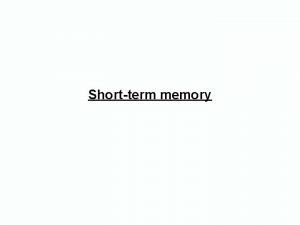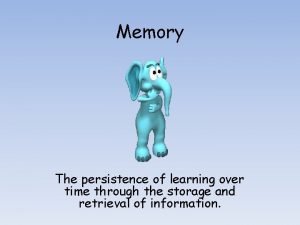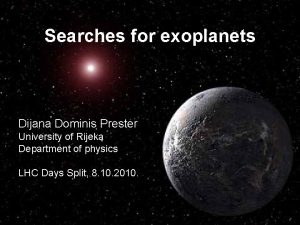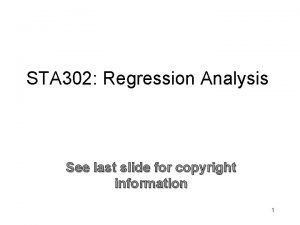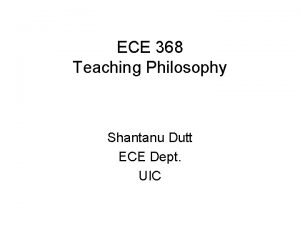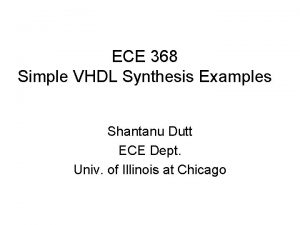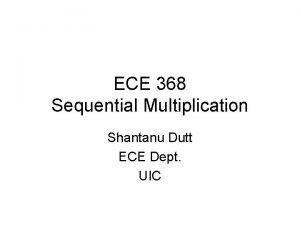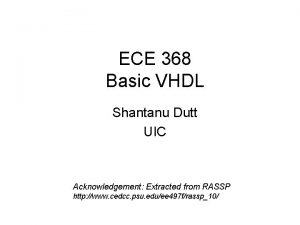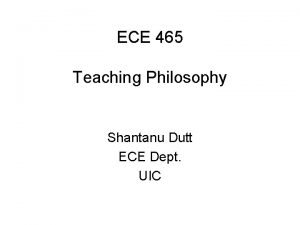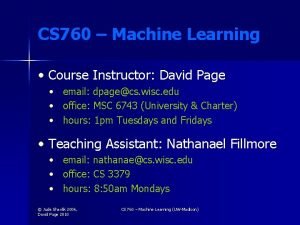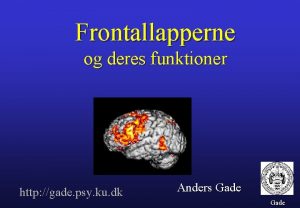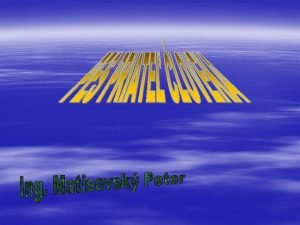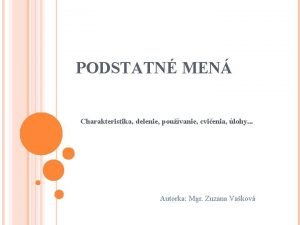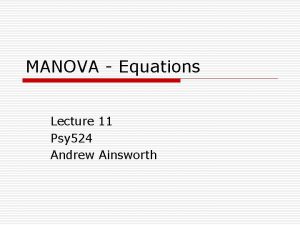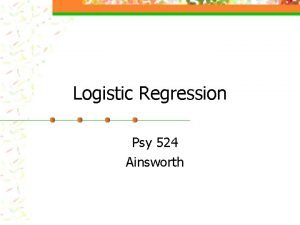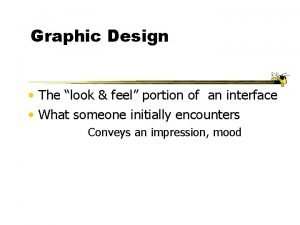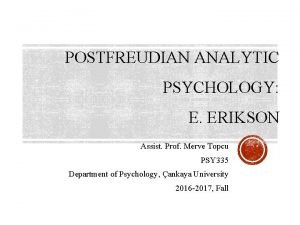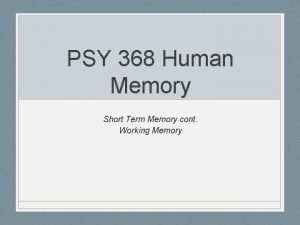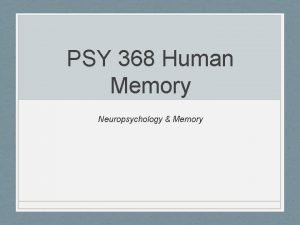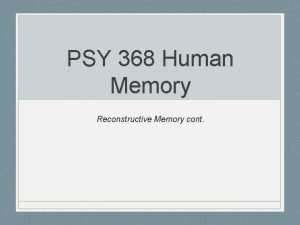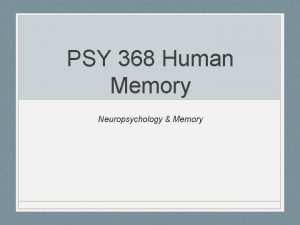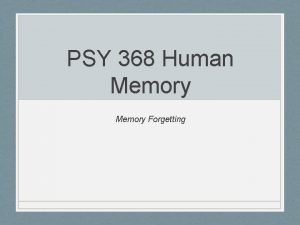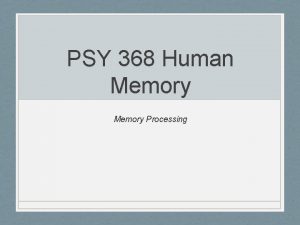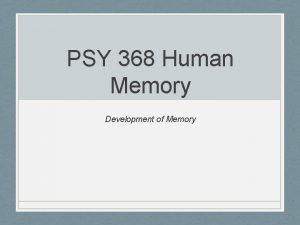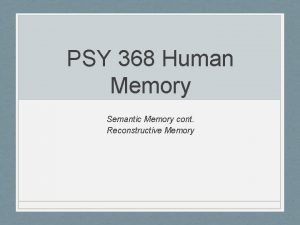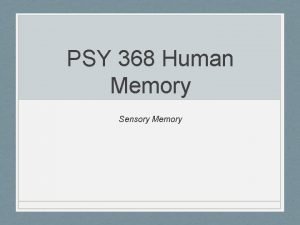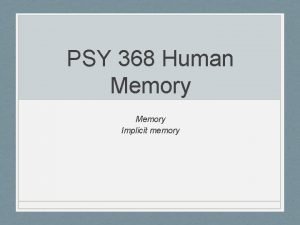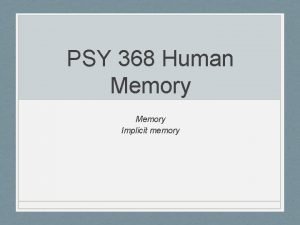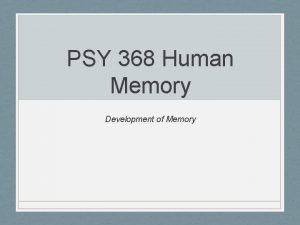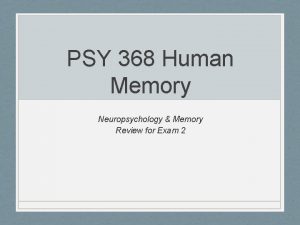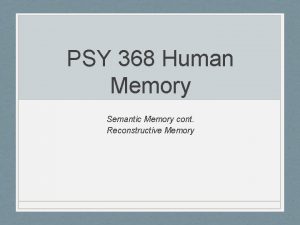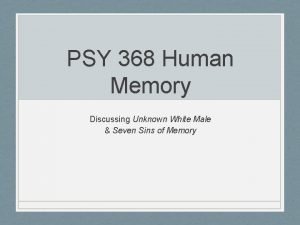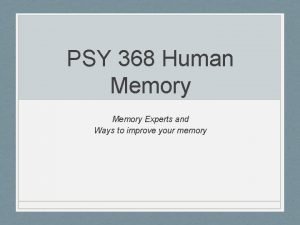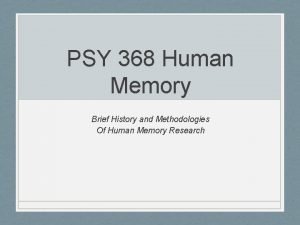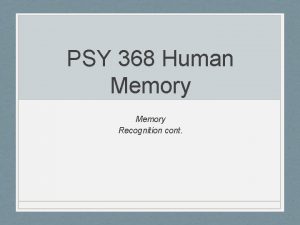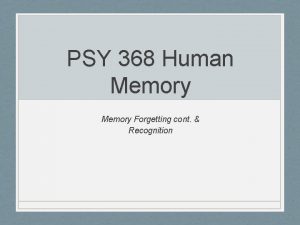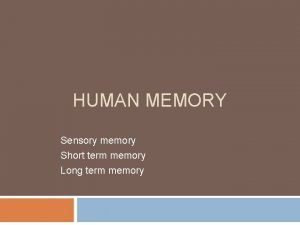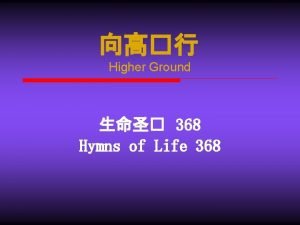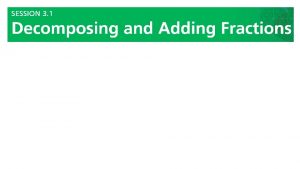PSY 368 Human Memory Short Term Memory Announcements






















































- Slides: 54

PSY 368 Human Memory Short Term Memory

Announcements • Quiz 2 today • Exam 1 Feb. 15 (Wed) • Experiment 1 Report. Due Feb. 15 (so start it early, so that you can study for the exam)

Experiment 1 assignment • Experiment 1 - Primacy and Recency Effects in Short-term Memory (modified from Neath & Surprenant book pg. 61) • Download from BB assignments page. Find 3 friends willing to participate • Report (Due Wednesday Feb. 15): The results for all subjects will be reported in class. Your assignment is to write a 2 -3 page report that includes the following: • brief description of the purpose and design of the experiment, including independent and dependent variables • brief description of the participants, materials, and procedure of the study, written in your own words • description of results and line graph of mean percentage recall by serial position • discussion of conclusions that can be made from the results. Include answers to these questions: • How long does short-term memory appear to last? • How important is attention to retrieval from short-term memory? • What kinds of everyday tasks in life use short-term memory?

Structural Model • Memory composed of storage structures that hold memories for a period of time • Sensory memory • Short-term memory (STM) or Working memory • Long-term memory (LTM)

Short-term Memory • Brief History • William James (1890) associated STM with consciousness • Also called “primary memory, ” “immediate memory, ” or “working memory” • Modal models are prevalent in descriptions of STM • Focus on memory structure

Modal Models • Broadbent (1958) • Three systems (stores): S-system (sensory), P-system (STM), LTM • Some sensory info (filtered) goes from S to P-system • Assumed STM had limited capacity and info must be REHEARSED to keep it from fading quickly • Atkinson-Shiffrin Model (1968) • • Sensory registers (by sense) Short-term store (STM) Long-term store (LTM) Executive control processes regulate flow of info between stores

Short-term Memory • Functions • Re-codes info from sensory memory for longer storage • Some info goes to long-term memory - stored for an indefinite amount of time • Rehearsal important part of STM • Rehearsal maintains a memory trace for a short period of time • Rehearsal helps transfer information from STM to LTM • Features • Capacity, Encoding, Duration, Retrieval

Short-term Memory • Features • Capacity, Encoding, Duration, Retrieval

STM Capacity How much information can be held in STM? • More limited capacity than Sensory memory • Span = Measure of STM capacity • Determined as 50% accurate ordered immediate recall of short list (3 -9 items) • Visual or auditory information

STM Capacity • Miller (1956) proposed capacity = 7 + or - 2 “chunks” of info • Chunk = unit of info recoded from the sensory input • 1 chunk = 1 letter = 1 syllable = 1 word, etc.

STM Capacity Finding your Span: Free recall • I’ll read a list of items to you, when I’m done I’ll ask you to recall as many of the items as you can (any order) • Ready • Read list aloud • Check list: MPWSOYNCQALB mop pie water sun olive yo-yo nose car quiz actor lake banana

STM Capacity • Span differs slightly depending on definition of“chunk”(varies with “complexity” of the chunk) • Digit span = 7. 7 • Word span = 5. 5 Letter span = 6. 35 Trigrams = 3. 2 • But span can also vary based on chunking abilities (integrated and elaborated with knowledge in LTM)

STM Capacity • Recoding can occur in STM if there is the time and mental resources available to reorganize the information • Using long-term memory to recode information – mnemonic devices • Using a well learned strategy to recode information • An example is verbally recoding information because language usage is over learned 13

STM Capacity: Chunking The capacity of the working memory may be increased by “Chunking” 1776198514922004 XCI AFB IVC RDN AIB MQZ X CIA FBI VCR DNA IBM QZ KCABLTCASIHET CATBLACKISTHE CAT IS BLACK

STM Capacity: Chunking The capacity of the working memory may be increased by “Chunking” 1776198514922004 XCI AFB IVC RDN AIB MQZ X CIA FBI VCR DNA IBM QZ KCABLTCASIHET CATBLACKISTHE CAT IS BLACK

STM Capacity: Chunking • Exceptional memory • Chase & Ericsson (1981) • Worked with S. F. , who over 2 years (320 one hour training in a lab practice sessions) increased digit span from 7 items to 79! • S. F. member of track and cross-country teams, and would relate digit strings to running times: • e. g. for string 4 1 3 1. . . • “I made four thirteen point one a mile time. . . ” • But also used other things • Remembers 1943 as “near the end of World War II” • But memory span for letters, words remained near 7

STM Capacity: Chunking • Chase and Simon (1973 a, 1973 b) • Used chess players • Novices – <100 hours • Experts – >10, 000 hours • Place pieces on the board (up to 24 of a middle game or random middle game) and players viewed for 5 seconds.

STM Capacity: Chunking • Chase and Simon (1973 a, • 1973 b) Information in memory is stored as ‘chunks’ • A chunk is a familiar pattern that can be used as a unit • Masters have about 100, 000 chunks • Chunks can be recognized instantly • It takes about 10 seconds to create a chunk

STM Capacity: Chunking • Chase and Simon (1973 a, 1973 b) n Chunks are linked to possible actions n In chess: identification of weaknesses, moves, plans f 1

STM Capacity: Chunking • Chase and Simon (1973 a, 1973 b) Results: • The chess master is better at reproducing actual game positions. • Master’s performance drops to level of beginner when pieces are arranged randomly.

STM Capacity Brief Summary • STM can hold about 7 ± 2 chunks of information But see Cowan (2000): Reviews 6 current views against this idea 1. 7 ± 2 is correct the material 2. Time is the limiting capacity not # of 6. items Separate capacity limits for storage and processing 3. No STM, all memory follows general 7. rules (e. g. , interference) There are capacity limits that are task specific 4. No capacity limits, but constraints on scheduling conflicts in performance 5. Multiple capacity limits depending on

STM Capacity: Encoding • What is the nature of the information encoded in STM?

STM Capacity: Encoding • Coding: the way information is represented • Types of coding • Auditory: acoustic, linguistic • Semantic: meaning • Visual: image • Studies indicate that most info stored AUDITORILY Conrad (1964) • Presented letters briefly, were to write down the letters. • Included letters that looked alike (V and X) or sounded alike (V and C) • Analysis of errors indicated the tendency to confuse letters with similar sounds – STM is auditory encoding

STM Capacity: Encoding • Coding: the way information is represented Baddeley (1966) • In all lists, the words either sounded alike (cat, hat, cat) had similar meanings (tiny, small, little) or were unrelated • Results: more errors when subjects studied lists of words that sounded alike (man, mad, cap) than words that have similar meanings (big, huge, long) • Conclusion: Similar sounding words confused in STM because memory code was acoustic. Semantically similar words confused in LTM because memory code was using meaning

STM Capacity: Encoding • Coding: the way information is represented Zhang & Simon (1985) • Chinese radicals (no sound) and characters (has sound) to Chinese native speakers. • Results –recalled 2. 7 radicals (visual code) versus 6. 4 characters (auditory code).

Visual coding in STM • Coding: the way information is represented Shepard & Metzler (1971) • Subjects shown 2 objects and asked if they were the same or different in different orientations • Results: Subjects took longer to answer when the object had been rotated further 600, 900, 1200 • Interpretation: people held the 1 st figure in STM and mentally rotated the 2 nd to make a comparison 26

STM Duration How long does information last in STM?

STM Duration • Duration of short term memory – Peterson & Peterson (1959)/Brown (1958) procedure • Experimenter says: CHJ 506 • Begin counting backwards by 3’s • After a set time, recall three letters • Subject says: 506, 503, 500…CHJ • After three seconds of counting, participants performed at 80% • After 18 seconds of counting, participants performed at 10%

STM Duration • Decay or Interference (Displacement)? • Could the counting backwards have actually interfered with memory – not just preventing rehearsal • Keppel and Underwood (1962) • Reexamination of Brown and Peterson data • Waugh and Norman (1965) • Was the memory loss the result of the passage of time- more loss as more time passed • Or was increasing the amount of counting backwards interfering with retention? • Wickens’ work (1963, 1970, 1972, 1976) • Release from proactive interference 29

STM Duration Keppel & Underwood (1962) • • Proposed P&P results because of the practice with trigrams in procedures. When practice was eliminated the effects of delay in recall show little effect. Short term memory, when rehearsal is prevented, is about 15 -20 seconds. Results P&P result: A large drop in memory for letters for a delay of 18 seconds between presentation and test Little decrease in performance on trial 1, and more decrease by trial 3. • Conclusion: previous trials interfered with later trials – proactive interference

STM Duration Waugh and Norman (1965) • Subjects verbally presented with lists of 16 digits at 2 presentation rates • 1 digit per second (takes 16 seconds to present list) • 4 digits per second (takes 4 seconds to present) • The last digit was the repeat of an earlier digit. Subjects asked to write down the digit that followed the earlier digit. 4, 2, 6, 8, 9, 2 correct answer is 6 7 0 8 4 1 6 0 9 5 5 3 7 2 4 7 8 • After the last digit, you hear a tone. . . 31 TONE

STM Duration Waugh and Norman (1965) • Subjects verbally presented with lists of 16 digits at 2 presentation rates • 1 digit per second (takes 16 seconds to present list) • 4 digits per second (takes 4 seconds to present) • The last digit was the repeat of an earlier digit. Subjects asked to write down the digit that followed the earlier digit. 4, 2, 6, 8, 9, 2 Probe correct answer is 6 7 0 8 4 1 6 0 9 5 5 3 7 2 4 7 8 TONE • The tone is a signal to recall one of the digits. The last digit before the tone (8) occurs only once at an earlier point in the list. 32

STM Duration Waugh and Norman (1965) • Subjects verbally presented with lists of 16 digits at 2 presentation rates • 1 digit per second (takes 16 seconds to present list) • 4 digits per second (takes 4 seconds to present) • The last digit was the repeat of an earlier digit. Subjects asked to write down the digit that followed the earlier digit. 4, 2, 6, 8, 9, 2 Probe correct answer is 6 7 0 8 4 1 6 0 9 5 5 3 7 2 4 7 8 Recall TONE • The subject’s task is to recall the digit following the probe. • Between the digit, 4, and the tone, two things happen: (1) time passes, and (2) more digits are presented. 33

STM Duration Waugh and Norman (1965) • Subjects verbally presented with lists of 16 digits at 2 presentation rates • 1 digit per second (takes 16 seconds to present list) • 4 digits per second (takes 4 seconds to present) • The last digit was the repeat of an earlier digit. Subjects asked to write down the digit that followed the earlier digit. 4, 2, 6, 8, 9, 2 Probe correct answer is 6 7 0 8 4 1 6 0 9 5 5 3 7 2 4 7 8 Recall TONE • Which is more important in causing forgetting, time or the more digits? • The decay principle implies time; the interference implies digits. 34

STM Duration Waugh and Norman (1965) • Subjects verbally presented with lists of 16 digits at 2 presentation rates • 1 digit per second (takes 16 seconds to present list) • 4 digits per second (takes 4 seconds to present) • The last digit was the repeat of an earlier digit. Subjects asked to write down the digit that followed the earlier digit. 4, 2, 6, 8, 9, 2 Probe correct answer is 6 7 0 8 4 1 6 0 9 5 5 3 7 2 4 7 8 Recall TONE • Time and digits are correlated (confounded). To separate them, two rates of presentation: slow (1 digit per second) and fast (4 digits per second). 35

STM Duration Waugh and Norman (1965) • Subjects verbally presented with lists of 16 digits at 2 presentation rates • 1 digit per second (takes 16 seconds to present list) • 4 digits per second (takes 4 seconds to present) • The last digit was the repeat of an earlier digit. Subjects asked to write down the digit that followed the earlier digit. 4, 2, 6, 8, 9, 2 Probe correct answer is 6 7 0 8 4 1 6 0 9 5 5 3 7 2 4 7 8 Recall TONE • If decay causes loss of information from short-term memory, the 16 second group should remember less because more time would have passed before they responded 36

STM Duration Waugh and Norman (1965) • Subjects verbally presented with lists of 16 digits at 2 presentation rates • 1 digit per second (takes 16 seconds to present list) • 4 digits per second (takes 4 seconds to present) • The last digit was the repeat of an earlier digit. Subjects asked to write down the digit that followed the earlier digit. 4, 2, 6, 8, 9, 2 Probe correct answer is 6 7 0 8 4 1 6 0 9 5 5 3 7 2 4 7 8 Recall TONE • Made this comparison with the probe digit in each of the following positions: 3 (shown here), 5, 7, 9, 10, 12, 13, or 14. 37

STM Duration Waugh and Norman (1965) • Subjects verbally presented with lists of 16 digits at 2 presentation rates • 1 digit per second (takes 16 seconds to present list) • 4 digits per second (takes 4 seconds to present) • The last digit was the repeat of an earlier digit. Subjects asked to write down the digit that followed the earlier digit. 4, 2, 6, 8, 9, 2 Probe correct answer is 6 7 0 8 4 1 6 0 9 5 5 3 7 2 4 7 8 Recall TONE • Results: Little to no (not significant) difference in recall with fast vs. slow presentation with probes near the beginning of the list. Recall dropped sharply as the probe was moved from the end toward the beginning. 38

STM Duration Waugh and Norman (1965) • Subjects verbally presented with lists of 16 digits at 2 presentation rates • 1 digit per second (takes 16 seconds to present list) • 4 digits per second (takes 4 seconds to present) • The last digit was the repeat of an earlier digit. Subjects asked to write down the digit that followed the earlier digit. 4, 2, 6, 8, 9, 2 Probe correct answer is 6 7 0 8 4 1 6 0 9 5 5 3 7 2 4 7 8 Recall TONE • Conclusion: As time passes, what mainly causes forgetting from short-term memory is exposure to additional information, not the passage of time. 39

STM Duration Wickens, Born, & Allen (1963) • Changing the nature of the items to be remembered reverses the decline in performance due to proactive interference- release from proactive interference • Two groups of subjects given 3 trials following the Brown. Peterson task (letters) - Memory performance declined with each trial • Control group given a 4 th trial using letters • Experimental group switched to remembering digits

STM Duration Wickens, Born, & Allen (1963) • Changing the nature of the items to be remembered reverses the decline in performance due to proactive interference- release from proactive interference • Experimental group, but not control group, performed perfectly; they were released from proactive interference 41

STM Duration Wickens (1970, 1972, 1976) • Proactive interference occurring as a result of semantic coding in STM • 5 groups of subjects given 3 trials of lists of 3 words each all from the same category where all list contained names of fruit • Group 1 – names of fruit • Group 2 – vegetable names • Group 3 – flower names • Group 4 - names of meats • Group 5 – names of different professions • Then all groups given a 4 trial where all list contained names of fruit 42

STM Duration Wickens (1970, 1972, 1976) • Results : 1 st trial all groups about 90% correct 2 nd trial more words in same category all groups about 50% 3 rd trial words still in same category all groups 35– 45 % 4 th trial , shift to fruit category professions 80%, meat 50%, flowers 47%, vegetables 40% and fruit 32%

STM Duration Wickens (1970, 1972, 1976) • Results: • Conclusion: • Information was coded using semantic information causing groups to confuse current list with previous lists

STM Retrieval How do we get information out of STM? • Retrieval from STM appears to operate by searching STM contents one at a time (serial search) • Sternberg (1966)

STM Retrieval Sternberg (1966) • study short list of 1 to 6 items followed by test probe - must decide if probe item was in list, measured time to make Y/N response • Two important variables were involved • The number of letters in each list • The location of the letter in the memory probe – in the beginning, middle, or end

STM Retrieval Sternberg (1966) • Parallel processing • Serial processing • Simultaneous handling • Operations being done after of multiple operations another • Response times should • It should take longer to retrieve four be the same, digits than to retrieve two digits regardless of the size • Exhaustive serial processing – the of the set of items, participant always checks the test digit because all against all digits in the set, even if a comparisons would be match were found partway through the list done at once • Self-terminating serial processing – the participant would check the test digit against only those digits needed to make a response

STM Retrieval Sternberg (1966) • Results • Response times increased linearly with set size but were the same regardless of serial position • It indicates that serial exhaustive model seems to • Conclusion: people search all be right • Subjects take longer to respond by probe (by 40 ms) when an additional item is added to the • list • Same results for probes that were in the list and probes that were not items in STM when asked to retrieve an item (happens very fast) Automatic process - fast and efficient, done for every item – doesn’t stop once a match is found

STM Retrieval Serial Position Curve • Primacy: • better recall for items in the beginning of the list than those in the middle • Recency: • better recall for items at the end of the list than those in the middle • due to retrieval from STM

STM Retrieval Free recall Curve • Primacy: • better recall for items in the beginning of the list than those in the middle • Recency: From Murdock (1962) • better recall for items at the end of the list than those in the middle • due to retrieval from STM • Models of STM propose that • Primacy is due to more rehearsal for items at beginning of list LTM • Recency due to immediate dumping of items from STM

STM Retrieval Free recall Curve vs. serial recall curves From Klien et al. (2005) • Primacy: • better recall for items in the beginning of the list than those in the middle • Recency: • better recall for items at the end of the list than those in the middle • due to retrieval from STM • Models of STM propose that • Primacy is due to more rehearsal for items at beginning of list LTM • Recency due to immediate dumping of items from STM • Recency is stronger effect than primacy in free recall

Problems with the Modal Models • When distractor task is done after every list item preventing items from staying in STM, recency effect still occurs • Primacy effects have also been shown to disappear when rehearsal is prevented

STM Summary • Duration: • STM is short store of about 20 s without rehearsal • Interference, rather than decay • Capacity: • Can hold 7 + or - 2 “chunks”(capacity) • Chunking increases capacity of STM • Encoding: Info mostly stored in auditory form • Retrieval: Modal models suggest recency effects mostly due to STM retrieval

More Recent Models • Current models of STM focus more on processing (than structures) and typically are models of Working Memory that include STM in some form
 Long and short
Long and short Long term memory vs short term memory
Long term memory vs short term memory Long term hr planning
Long term hr planning Short, medium and long term planning in education
Short, medium and long term planning in education Difference between long term and short term liabilities
Difference between long term and short term liabilities Accounting for serial bonds
Accounting for serial bonds Short term goals
Short term goals Short-term financial management
Short-term financial management Short term memory computer
Short term memory computer Short term memory
Short term memory Short term memory in psychology
Short term memory in psychology The persistence of learning over time
The persistence of learning over time Ogle 2007 blg 368 lb
Ogle 2007 blg 368 lb Sta 302
Sta 302 Stars-368 av
Stars-368 av Ece 368
Ece 368 Ece 368
Ece 368 Ece 368
Ece 368 Ece 368
Ece 368 Ece 368
Ece 368 Cs 368 uw madison
Cs 368 uw madison Bc 368
Bc 368 Pvu announcement
Pvu announcement R/announcements
R/announcements Church announcements
Church announcements Fahrenheit 451 burning bright summary
Fahrenheit 451 burning bright summary Potentiial
Potentiial General announcements
General announcements Euro psy
Euro psy Ucf online psychology degree
Ucf online psychology degree Psy2055
Psy2055 Psy 2055
Psy 2055 Psy 2055
Psy 2055 Psy
Psy Psy sanin
Psy sanin Psy
Psy Psy
Psy Psy
Psy Psy
Psy Psy 226
Psy 226 Suppose twin teenagers are vying
Suppose twin teenagers are vying Alla kulikova
Alla kulikova Nukleus caudatus
Nukleus caudatus Psy walsh
Psy walsh Veľký bradáč charakteristika
Veľký bradáč charakteristika Abstraktné podstatné mená
Abstraktné podstatné mená 11 psy
11 psy Regression psy
Regression psy Psy
Psy What is adoloscence
What is adoloscence Term-to-term rule
Term-to-term rule Quadratic sequence
Quadratic sequence Term to term rule
Term to term rule Minterm
Minterm Nth term rule
Nth term rule









